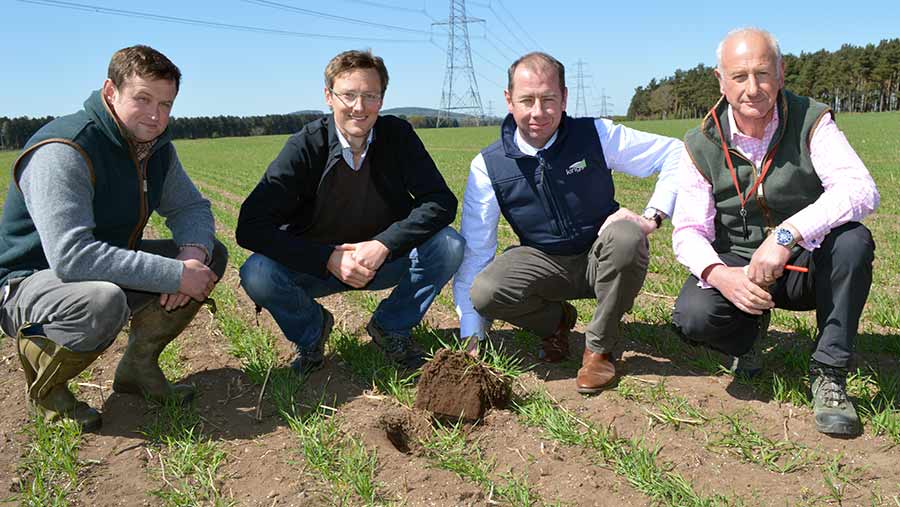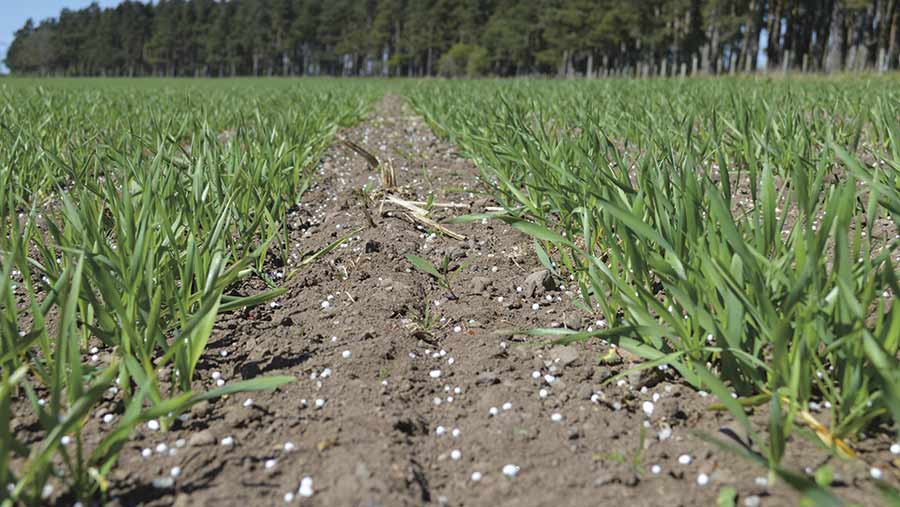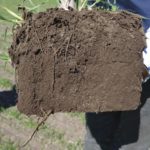Three-pronged plan to raise soil fertility in Northumberland
A four-year plan is under way to improve the fertility of light blow-away soils on a Northumberland farm by successive cycles of cover crops, grazing sheep and spring barley.
The early signs are encouraging with soil health starting to look better, which will hopefully feed through to higher barley yields, while more fat lambs are being finished on the farm.
The spring barley crop was looking good in early May and coping better than expected with a dry spring spell of weather, helped by two winters of cover crops and sheep-led fertility.

Richard Jeffreys (l to r) Peter Jeffreys, Richard Barnes, Donald Pearsons
See also: Trial aims to quantify cover crop cost benefits
Arable grower Peter Jeffreys sees the key to this strategy is being able to direct drill his cover crops straight after the combine to give time for them to establish in the short autumns in northern England.
“If I can establish the crop by direct drilling the system works for me, and we are now starting to see more worm activity in the soil,” he tells Farmers Weekly.
Soil benefit bonus
The costs of cover crop seed and drilling are being well covered by finishing 350 store lambs as fat, while the soil benefits come as a bonus.
It was back in autumn 2015 when Mr Jeffreys opted for this new strategy to reverse declining crop yields on a block of low-lying, very light sandy land.
This 50ha area was close the River Till, which runs north into the Tweed at the Scottish border, on Mr Jeffreys’ 400ha farm at Kimmerston, some five miles north of Wooler.
Winter wheat yields on this riverside block of light land had dropped 2.5t/ha below the farm average of nearly 9t/ha, so some action was needed.
See also: Spud headland cover crop trial expanded for second season
Declining yields
“We have struggled with a long-term trend of declining yields with the soils showing moisture retention problems,” he says.
The decline in wheat prices highlighted the problem, as when wheat prices were £200/t-plus the economics looked fine but as prices moved towards £100/t it was time to act.
But there was no ready supply of farmyard manure and grass leys were not an option as the lighter land was part of a 230ha arable rotation, with the remaining land in grassland and environmental schemes.
The arable rotation was dominated by autumn-drilled wheat, barley and oilseed rape, while some land has been rented out for vining peas.
Radical plan
Mr Jeffreys, together with agronomist Donald Pearsons from advisory group Frontier, had tried trace elements and foliar feeds with limited success and decided a more radical plan was needed.
“We were looking to improve the soil structure and halt the decline in yields so we turned to cover crops,” says Mr Pearsons.
The soils were tested and seen to be surprisingly high in organic matter while nutrient levels were generally good, but they showed very low microbial activity with and poor earthworm counts.
A plan was hatched to move away from the largely autumn-drilled regime to a three-pronged cover crop-sheep grazing-spring barley routine for four years.
Greater resilience
Richard Barnes, sales manager at Frontier’s sister company selling cover crop seed Kings, suggested that cover crops could improve soils structure and lead to greater resilience to these sandy soils.
“This land is in intensive care at the moment and doing nothing to this block was not an option,” he says.
 He devised a four-way cover crop mix with spring forage rye and phacelia as shallow rooters, oil radish as a medium-rooting crop and tillage radish giving a deep-rooting element to the mixture.
He devised a four-way cover crop mix with spring forage rye and phacelia as shallow rooters, oil radish as a medium-rooting crop and tillage radish giving a deep-rooting element to the mixture.
The aim was to improve the soil structure and give good grazing forage, and each component had a role in the seed mix chosen.
See also: Broadcasting seed can slash the cost of establishing cover crops
Bulky crops
Of the shallow rooting crops, the spring forage rye produces a big bulky crop for grazing with shallow but dense roots, while phacelia is good for encouraging soil microbial activity.
Oil radish produces a tap root but also fibrous lateral roots down to a medium depth, while tillage radish’s role is for deep rooting and improved structure at depth.
Three broad mixtures of the four-way cocktail were tried costing £42-£49/ha at a relatively high seed rate of 25kg/ha, and including a contractor to direct drill the crop gave a total establishment cost of about £65/ha.
In the autumn of 2015, some 47ha of cover crops were drilled after the combine with a first block sown on 25 August and the rest two weeks later, with the early drilled area, as expected, seeing better establishment.
Ewe flock
Mr Jeffreys’ cousin, Richard Jeffreys, returned to the farming business from an advisory role with Scotland’s Rural College to take charge of a 300-strong Mule ewe flock with most lambs sold fat off grass.
In the autumn of 2015, bought-in young gimmer breeding stock were used to graze off the cover crops, but in the autumn and winter of 2016 it was used to fatten lambs.
 This came as the flock was pushed up to 900 ewes, which put a strain on the farm’s ability to fatten all the lambs on grass, so out of 450 store lambs not fattened on grass, some 350 were finished on the cover crops.
This came as the flock was pushed up to 900 ewes, which put a strain on the farm’s ability to fatten all the lambs on grass, so out of 450 store lambs not fattened on grass, some 350 were finished on the cover crops.
This boosted the value of the farm’s Mule-Texel lambs to make £70 a head as fatstock rather than £50 a head as store lambs, so boosting returns from the sheep while improving the soils.
Cover crops established well in two generally mild autumns and the lambs are now rotated around the light land block from November through to the end of January.
Concerto chosen
The malting spring barley variety Concerto was chosen to follow the cover crops, and gave a yield of 5.2t/ha at harvest 2016 with the grain making malting grade and heading for the distilling industry.
“Hopefully this spring barley yield will move up a bit, especially as we are direct drilling the crop in March,” says Mr Pearsons.
The cover crop leaves the soil in a good condition to give an early start for the spring barley drilling, so after a glyphosate spray in late February to clean up any weeds, the direct drilling starts in March to conserve as much soil moisture as possible.
This year, the barley crop has established well despite a very dry spring, and by early May was looking good despite the need for some rain.
“These fields are very susceptible to dry spells and we would normally expect them to look more stressed than this,” adds Mr Jeffreys.

